
|
Comerica Park is an HOK Sport-designed, Camden Yards-inspired, picturesque throwback era ballpark situated in the heart of downtown, just like its template is in other major American cities.
Detroit's version was one of three such venues to open in 2000 (Houston and San Francisco were the others), which further underscores that the Tigers' home is the modern era's version of an "assembly line" ballpark. Not that that's a bad thing, as each new HOK-designed and downtown situated ballpark has wowed the local fan base, and the Detroit faithful are likewise satisfied end-users. No matter where they flock to the ballpark from, fans' first glimpse of Comerica Park will most likely include its all-brick exterior, which is circled by numerous stone tiger heads that have a baseball between clinched teeth. The two main entrance gates, both down the right field line, are guarded by huge tigers with menacing scowls. In all, nine tigers, weighing an average of 5,000 pounds, are displayed above or near the entrances. Each was the work of New York-based artist Michael Keropian. Although not as omnipresent on the inside, Comerica Park does have brick in the one place it is most likely to be noticed: the area extending from either side of the tree-lined hitter’s backdrop. When watching the game on TV, the brick dominates the background and takes up large portions of what’s visible on the screen. But when you actually watch a game at Comerica in person, you hardly notice it.
The last names of Tiger legends that played before numbers were worn adorn the right-center field stretch of brick. A notable exception is the name Harwell, for the famed Tiger broadcaster who retired following the 2002 season after 55 years in the booth. Besides getting a Tigers history lesson, the outfield concourse that stretches from left to right field is also a good place to watch the game for a couple of innings. If you really want to be immersed in Tigers history, then “The Walk of Fame” spread out along the main concourse on the opposite side of Comerica is where you should go to get your learn on. The Decade Monuments there cover two 10-year periods of team history at a time in floor to ceiling displays with corresponding era artifacts. Comerica Park has many other distinctive features, although not all of them are original. The first thing you notice when you look out towards the playing field is the huge scoreboard in left field. At ten stories and 147 feet high by 202 feet wide, it was the largest in baseball when it debuted in 2000. The inspiration for the supersized board was Jacobs Field's jumbotron, which was baseball’s biggest until Detroit copied the feature and made theirs slightly bigger. Sitting atop the scoreboard, on either side, are a pair of orange and black tigers, whose eyes flicker green when a Tiger hits a home run and during the classic Survivor song “Eye of the Tiger.” The light towers are in the form of toothbrushes, just like those at Cleveland’s (since renamed) Jacobs Field. While Tiger Stadium’s distinctive bank of lights could be spotted from most places in Detroit, Comerica Park is only visible from a short distance. The field is dug below street level, so the ballpark doesn’t appear to be very large as you approach it from the outside. Directly above the hitter’s backdrop in center field is the recently renamed Chevrolet Fountain, which remains dormant during the game unless a Tiger homers. It is used before and after games when it spurts water streams that are choreographed to music. The fountain is also the centerpiece of the fireworks show that occurs after most Tigers’ Friday and Saturday night home game. Spraying water up to 150 feet high, the fountain is programmed to changing lights as well as music. If you sit in the upper deck, you can easily see the cylinder-shaped headquarters of General Motors directly behind the fountain that they sponsor (Chevrolet is a GM brand). On the topic of sponsors, when I first heard the name Comerica Park I had no idea what Comerica was. Actually a bank, it sounded circus-like to me and inside the stadium you’ll find a pair of carnival rides to follow up on that notion. There is a carousel with 30 hand-painted tigers to merry-go-round in the middle of the circular food court on the park's first base side. For further amusement, a 50-foot high Italian-made Ferris wheel with 12 cars shaped like baseballs is close to the Brushfire Grill on the third base side of the park. The cost to ride each is a couple bucks, except on Sunday when kids 14 and under get to ride for free. As for the ballpark fare, there are a number of Little Caeser’s pizza stands throughout the ballpark, which is no surprise since the Tigers’ owner made his millions by founding the chain in 1959. The cola of choice is Pepsi. As all newer ballparks do, Comerica has a restaurant/bar located on its premises, specifically in right field near Gate B, which is where a McDonald’s was originally placed, then replaced four years later by Montgomery Inn, a BBQ joint that had a 5-year run until it too was replaced in 2009 by The Labatt Blue Light Jungle Bar. Although not exactly knothole gang-esque, you can actually watch the game without having to pay admission if there is a sparse crowd, as the field and most of the action that takes place on it can be easily seen from the avenue (Adams) running behind Comerica in right-center. Only if there are lots of fans within the stadium milling about the outfield concourse will your sight be obstructed. Fans that do pay to watch the game get a complimentary copy of the Detroit News, which prints a special baseball-only Comerica Park sports section. The paper is very thorough in its coverage and has some good feature pieces on both the Tigers and the visiting team. Whether that has changed since my multiple visits to Comerica in 2002, I do not know. But at least Detroit has remained a two newspaper town since then (the Free Press is still going strong), while elsewhere it has become common for only one big city daily to survive the digital revolution. A by-product of the modern ballpark building revolution are the pleasing backdrops that have ensued, hence the Tigers have a ballpark that is framed by the downtown Detroit skyline from center to right field. Just beyond center field is the stately Detroit Athletic Club building, which was built so long ago (1915) that Ty Cobb had a membership there. Looming large behind the third base grandstand is the 8-year old home of the Detroit Lions, Ford Field, which hosted the Super Bowl in 2006 and Final Four in 2009. While nobody will miss the Lions’ former home, the Pontiac Silverdome in the nearby suburbs, baseball fans still wax nostalgic about Comerica Park’s predecessor, Tiger Stadium, which stood at the corner of Michigan and Trumbull for 97 years. The two ballparks were a short walk from each other, separated by only 1.37 miles, but Comerica has the dubious distinction of replacing the baseball cathedral and registered Michigan historic site that hosted Tiger baseball for 88 years. Although I never saw a game at Tiger Stadium, I made the short pilgrimage by foot to see “The Grand Old Lady at The Corner” on June 5, 2002. Unfortunately, by that time the stadium had been left to decay. Owned by the city, but maintained by the Tigers, the ballpark was not open to the public, there were no tours, and the last pieces of Tiger Stadium were finally hacked down at 9:24 a.m. on September 21, 2009, almost ten years to the day in 1999 (September 27) that the Tigers played their last game there. Tigers owner Mike Ilitch, a former minor league player for Detroit in the 1950s, abandoned Tiger Stadium because he felt it didn't have enough luxury suites and he couldn’t control parking revenue. Apparently to make up for lost time, parking isn’t cheap at the new ballpark. I saw nothing for less than $10 and the Comerica Park parking lots will set you back at least an Andrew Jackson. The cost to rent one of the ballpark's 105 suites makes the $20 parking look like a bargain in comparison. Despite his baseball background, for a long time Ilitch spent the bulk of his finances on talent for the Detroit Red Wings, which he also owns, and while the hockey team was winning Stanley Cups, the Tigers suffered through a dozen consecutive losing seasons, hitting near historic rock bottom when they went 43-119 in 2003. The Tigers' losing ways alienated the proud Detroit baseball fandom and attendance at Comerica after its first season was sparse. Things finally changed in 2006, when Ilitch loosened the purse strings and the Tigers' payroll rose to $82 million, a full $33 million higher than it had been in the depth of despair days just three years prior. And just like that, Detroit fielded a winning baseball team, going all the way to the World Series in '06. With a fan base no longer unfulfilled, the majority of Comerica Park's green seats are now filled when the team is in town. The 2007 squad became the first to be watched by over 3,000,000 patrons, and the 2008 team drew an astounding 3,202,645 paying customers in a year that ownership also spent a Tigers' record $137 million on payroll. What fans of all ages and players of all wages will discover upon their first trip to Comerica Park is a lovely ballpark in a great setting. True, it had the misfortune of replacing one of baseball's finest cathedrals, but once a quality product was placed on its Kentucky Bluegrass playing field Detroiters warmed up to Tiger Stadium's successor.
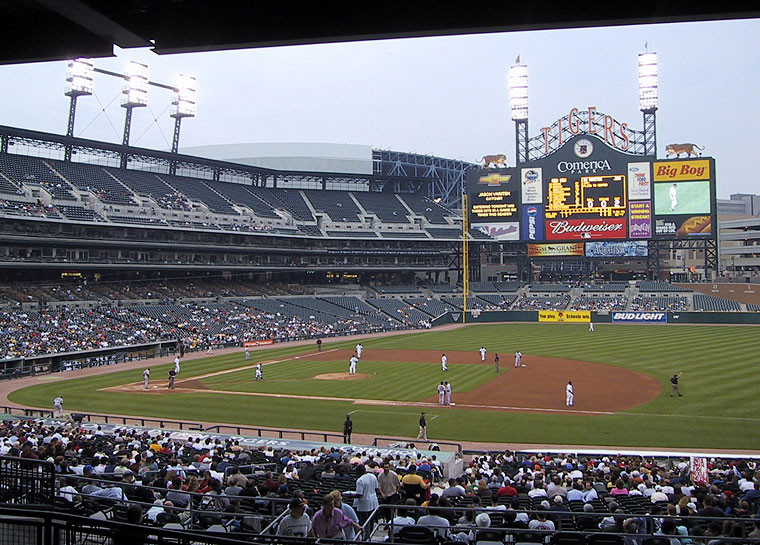
Comerica Park Facts, Figures, Firsts & Footnotes
| ||||||||||||||||||||||||||||||||||||||||
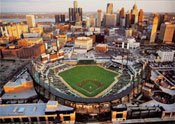
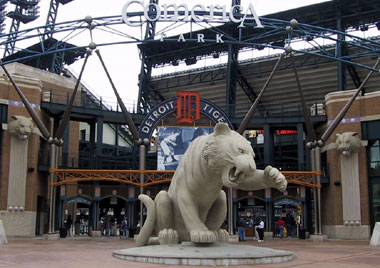
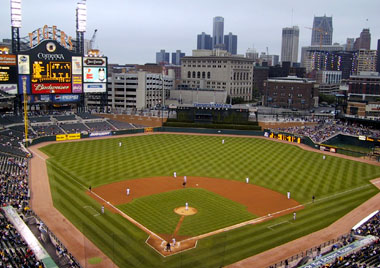
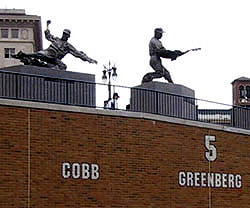 The brick wall serves as a Tigers Wall of Fame, with last names of six Tigers immortalized on the wall in left-center. On the concourse above, there are six 13-foot tall sculptures of former Tiger greats Al Kaline, Hal Newhouser, Charlie Gehringer, Hank Greenberg, Ty Cobb, and Willie Horton. Aside from Cobb, who played before there were numbers, the other five have their retired number etched in the brick directly below their statues, which were cast in stainless steel and sculpted by Omri Amrany.
The brick wall serves as a Tigers Wall of Fame, with last names of six Tigers immortalized on the wall in left-center. On the concourse above, there are six 13-foot tall sculptures of former Tiger greats Al Kaline, Hal Newhouser, Charlie Gehringer, Hank Greenberg, Ty Cobb, and Willie Horton. Aside from Cobb, who played before there were numbers, the other five have their retired number etched in the brick directly below their statues, which were cast in stainless steel and sculpted by Omri Amrany.

